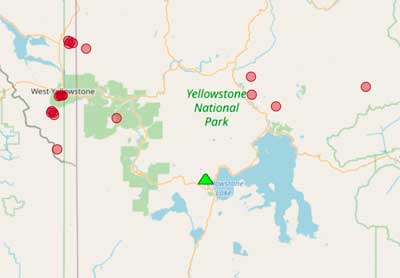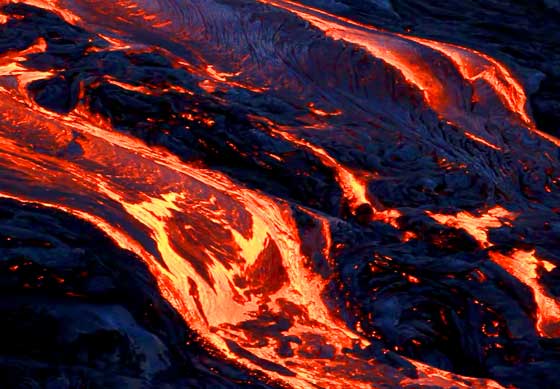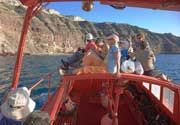Science Spotlight: Atypical Magmas
by Leandra Xochitl Marshall, published 23 April 2023
What is Magma?
Magma is molten rock found beneath Earth's surface, composed of varying water levels, gasses, and different mixtures of minerals. When erupted onto the surface of the Earth via volcanoes, magma is called lava. Magma and lava compositions typically fall under three categories, described in the following sections. Most volcanoes are capable of producing more than one magma or lava composition, which generally depends on the specific geologic and tectonic settings found at the volcano. For example, magmas formed from mantle materials have higher levels of iron, magnesium, and calcium, and are silica-saturated.
Mafic Magmas
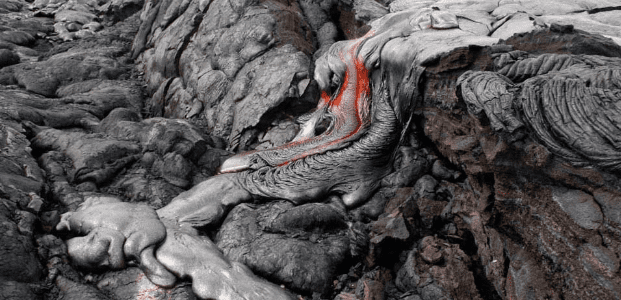
Hawaiian Basaltic Lava Flow. Photo Credit: U.S. National Park Service.
Mafic magmas are rich in metals such as iron, magnesium, and calcium, and low in potassium and sodium. They contain 45-55% silica (SiO2) or quartz, and tend to flow more fluidly. Mafic magma is often found at oceanic hotspots, where mantle plumes cause magma to rise to the surface, and divergent tectonic plate boundaries. However, they can also be produced by volcanoes at subduction zones. Most mafic minerals are dark in color, and include the minerals olivine, pyroxene, amphibole, and biotite. Common mafic igneous rocks are basalt, diabase, and gabbro.
Intermediate Magmas
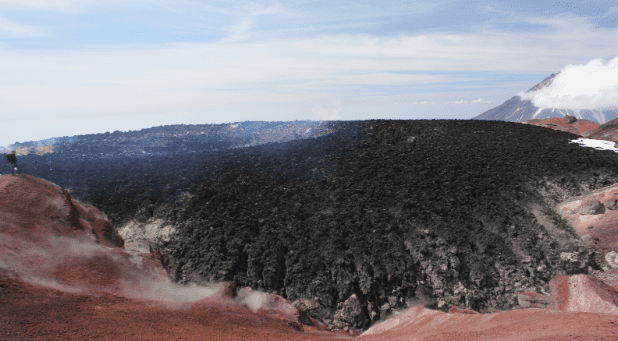
Basaltic Andesite Lava Flow, Avachinsky Volcano, Kamchatka, Russia. Photo Credit: Wiki Commons, Einar Fredriksen.
Intermediate magma contains a medium amount of metals and 55-65% silica, and rocks produced from this parent magma tend to be intermediate in color between mafic and felsic compositions. As a result, intermediate magma is more viscous and does not flow as fluidly as mafic magma does. This causes intermediate magma to flow more slowly and thus behave more explosively than mafic magma. Intermediate magma is typically found at convergent tectonic plates. Basaltic andesite, andesite, and dacite are examples of intermediate igneous rocks.
Felsic Magmas

Rhyolitic Lava Dome, Mono Crater, California, U.S. Photo Credit: Wiki Commons, Daniel Mayer.
Felsic magma is low in iron, magnesium, and calcium, but high in potassium and sodium. Felsic magma contains 65-75% silica, and is very viscous and resistant to flow. This type of magma tends to produce explosive eruptions, and is commonly seen at convergent plate boundaries or continental hotspots. Felsic rocks are often light in color. Examples of felsic igneous rocks are rhyolite and granite.
Atypical Magmas
Sometimes volcanoes can produce other magma compositions that are more extreme versions of the common categories, or even atypical magma compositions that are either rare on Earth or currently nonexistent except in the geological record. Some examples of these interesting magma compositions are found below.
Alkali-Rich Magmas
Alkalinity, based on the weight percent of Na2O + K2O in magma, is another means of magma classification. Although these lavas can occur in a variety of tectonic settings, they are typically found in either (1) continental or oceanic intraplate settings, where there is often a lack of significant tectonic control, (2) continental rift zones, and (3) the back-arc setting of subduction zones. Alkali-rich lavas are often characteristic of waning stages of volcanism, such as in the late-stage Hawaiian shield volcanoes.
Example: Iron Oxide Magmas

Iron oxide copper gold ore from Prominent Hill, Australia. Photo Credit: Wiki Commons, Geomartin.
Iron oxide magma is formed from separation from an alkaline parental magma. For example, iron oxide magmas are thought to be the source of the iron ore at Kiruna, Sweden which formed during the Proterozoic. These iron-rich porphyry deposits formed from magmatic hydrothermal fluids exsolved from relatively oxidized, Sulfur-rich, calc-alkaline to mildly alkaline, arc-related magmas.
Silica-Undersaturated Magmas
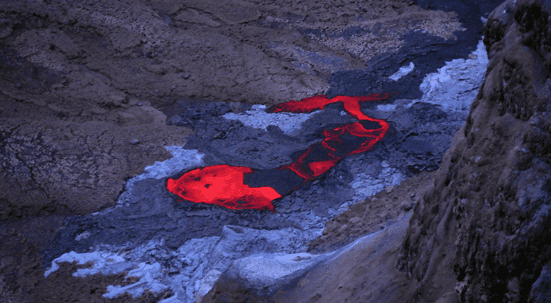
Active carbonatite/natrocarbonatite lava flows on Ol Doinyo Lengai. Photo Credit: Global Volcanism Program and Jeremey Riffault.
Silica-oversaturated magmas contain abundant quartz minerals, whereas silica-undersaturated mafic igneous rocks do not. The lack of silica results in the crystallization of feldspathoids such as nepheline and leucite. Silica-undersaturated, mafic igneous rocks are much less common than silica-saturated and oversaturated basalts.
Example: Natrocarbonatite Magmas
Alkali-enriched (Na and K) carbonatite magmas are called natrocarbonatite magmas. Natrocarbonatite lava flows turn white after interacting with water on the surface.
Example: Melilite and Nephelinite Magmas
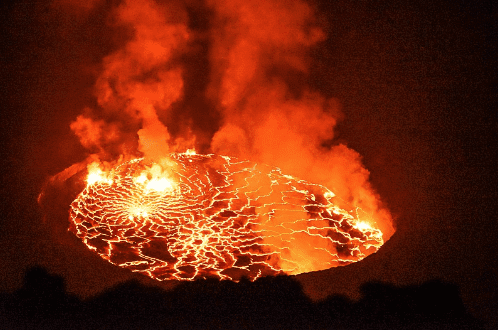
Nyiragongo lava lake. Photo Credit: Wiki Commons.
Melilite and nephelinite magmas contain relatively high concentrations of light rare earth elements, and are usually formed during high-pressure melting, low-degree fractional melting from a mantle source, and with high levels of dissolved carbon dioxide.
Nephelinite is found on volcanic islands such as Oahu and Japan, and in alkaline continental rift zones such as the East African Rift. Another African volcano known for its lava lake, Nyiragongo in the Democratic Republic of Congo, erupts melilite-nephelinite lava. The lava owes its notorious fluidity and speed to its melilite-nephelinite composition.
Example: Phonolite Magmas
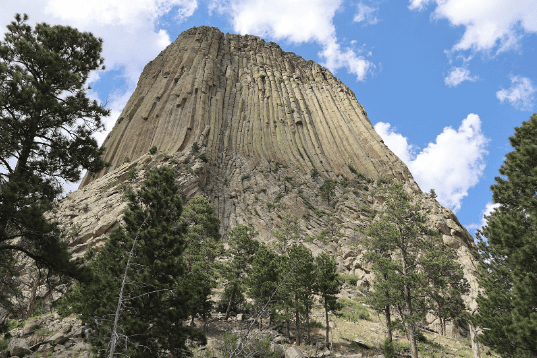
Porphyritic phonolite, Devils Tower in Wyoming. Photo Credit: Wiki Commons, Jonathunder.
Phonolite magmas generally form from small-volume eruptions at intracontinental mantle plumes. These alkali-rich magmas are generated by fractionation from low-silica melts such as melilite and nephelinite magmas. Since the magma lacks quartz or other silica crystals, they are dominated by low-silica feldspathoid minerals more than feldspar minerals. A famous example of phonolite magma is the Devils Tower in Wyoming.
Ultramafic Magmas
Ultramafic magmas have very low silica content (<45%) and are mostly composed of dark mafic minerals with high magnesium and iron content, such as olive and pyroxene. These magmas rarely reach Earth's surface and generally occur as intrusive bodies.
Example: Komatiite Magma
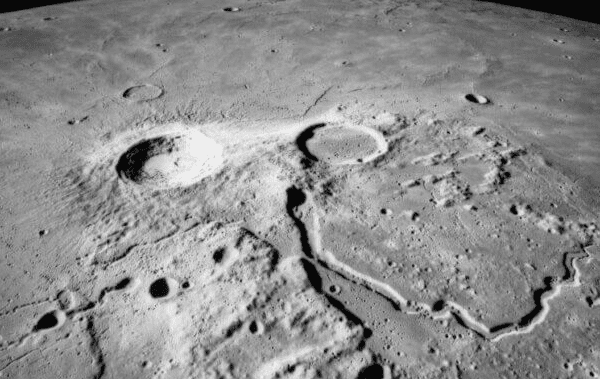
Schroeter's Valley on the Moon, sculpted by komatiite lava flows. Photo Credit: NASA.
Komatiite magma has very low silica content (40-45%) and high magnesium content (18%). No komatiite magma is known to exist on Earth today. Earth's mantle has cooled too much to produce highly magnesian magmas.The youngest komatiites on Earth are about 90 million years old, but most other examples are older than 3 billion years. Earth's internal heat was substantially greater billions of years ago, resulting in the eruption of komatiite lavas with eruption temperatures greater than 1,600 degrees C. Basaltic lavas today have eruption temperatures of around 1,100 degrees C. Scientists believe that the Moon has had komatiite lava flows, which carved deep valleys with their immense heat.
Ultrapotassic Magmas
Ultrapotassic magmas are generally ultramafic or low-silica mafic. Ultrapotassic magmas are formed by melts containing subducted sediments, or magmas that have been potassium-enriched by melts or fluids partly derived from subducted sediments. Although no modern eruptions have been observed, most occurrences on Earth are found in volcanic and subvolcanic diatremes and maars.
Example: Kimberlite Magmas
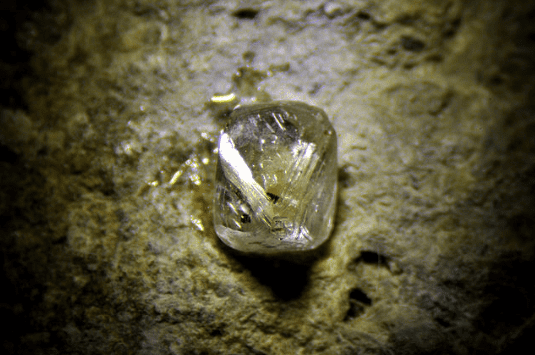
South African kimberlite with diamond. Photo Credit: Géry Parent, Wiki Commons.
Kimberlite magmas are formed from exotic magma compositions enriched with potassium and rare earth elements. They occur in the Earth's crust in vertical structures known as kimberlite pipes, which erupt violently in high-temperature, high-pressure conditions, and with high volatile content. Kimberlite pipes are Earth's most important source of mined diamonds.
Superhydrous Magmas
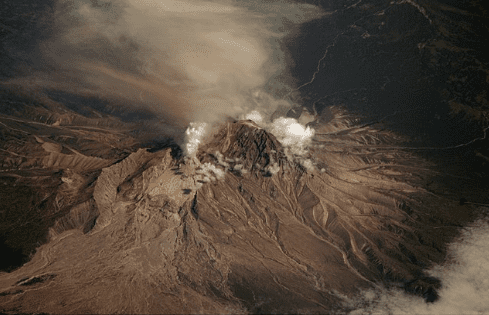
Shiveluch volcano. Photo Credit: Earth Science and Remote Sensing Unit, Lyndon B. Johnson Space Center.
Water-rich magmas, or superhydrous magmas, contain higher proportions of volatiles, or gasses, that increase the buoyancy of the magma and allow the magma to migrate to the surface. This increase in gasses also increases the pressure of the magma, leading to more violent and explosive eruptions.
Most volcanoes have a magma composition of less than 1% water by weight (wt. %). The average water content of the upper mantle is 0.01 wt. %. For volcanoes located in subduction zones, the average is approximately 4 wt. %. Above 8 wt. %, magma is considered superhydrous. Scientists use the mineral amphibole as evidence of high water content in magmas. The unique chemistry of the mineral tells researchers how much water is present deep In Kamchatka, Russia, the amphiboles present inside Shiveluch volcano indicate that its magma contains approximately 10-14% water by weight. Scientists consider Shiveluch to be the most regularly-active explosive volcano in the world because of its unique superhydrous magma composition.
References
Ahmadzadeh, G., Jahangiri, A., Lentz, D. and Mojtahedi, M., 2010. Petrogenesis of Plio-Quaternary post-collisional ultrapotassic volcanism in NW of Marand, NW Iran. Journal of Asian Earth Sciences, 39(1-2), pp.37-50.
https://doi.org/10.1016/j.jseaes.2010.02.008
Bachhar, Priyanka, et al. 2021. Mantle heterogeneity and crust-mantle interaction in the Singhbhum craton, India: New evidence from 3340 Ma komatiites. Lithos 382, 105931.
https://doi.org/10.1016/j.lithos.2020.105931
Goltz, A.E. et al 2020. Evidence for superhydrous primitive arc magmas from mafic enclaves at Shiveluch volcano, Kamchatka. Contributions to Mineralogy and Petrology, 175, 115. https://doi.org/10.1007/s00410-020-01746-5
Green, D. H. 1981. Petrogenesis of Archaean ultramafic magmas and implications for Archaean tectonics. Developments in Precambrian Geology. Vol. 4. Elsevier, 469-489.
https://doi.org/10.1016/S0166-2635(08)70024-0
Green, D.H. and Ringwood, A.E 1967. The genesis of basaltic magmas. Contr. Mineral. and Petrol. 15, 103–190.
https://doi.org/10.1007/BF00372052
Hirschmann, M.M. 2006. Water, Melting, and the Deep Earth H2O Cycle. Annu. Rev. Earth Planet. Sci. 34, 629–653.
https://doi.org/10.1146/annurev.earth.34.031405.125211
Ivanikov, V.V., Rukhlov, A.S., and Bell, K. 1998. Magmatic Evolution of the Melilitite–Carbonatite–Nephelinite Dyke Series of the Turiy Peninsula (Kandalaksha Bay, White Sea, Russia), Journal of Petrology, Volume 39, Issue 11-12, November 1998, Pages 2043–2059.
https://doi.org/10.1093/petroj/39.11-12.2043
Melluso, Leone 2014-2017. Petrogenesis of Alkaline and Strongly Alkaline Volcanism: Examples from African Rift. PhD Thesis, University degli Studi di Napoli Federic II.
http://www.fedoa.unina.it/12308/1/Tesi_PHD_SM.pdf
Nna-Mvondo, Delphine and Martinez-Frias, Jesus 2007. Review komatiites: from Earth's geological settings to planetary and astrobiological contexts. Earth, moon, and planets 100.3-4 (2007): 157-179.
https://doi.org/10.1007/s11038-007-9135-9
Papale, P., Neri, A., and Macedonio, G. 1998. The role of magma composition and water content in explosive eruptions: 1. Conduit ascent dynamics. Journal of Volcanology and Geothermal Research 87.1-4, 75-93.
https://www.academia.edu/download/48029997/s0377-0273_2898_2900101-220160813-27762-1gj7nrc.pdf
Paul, D.K. and Potts, P.J., 1976. Rare-earth abundances in kimberlites from Greenland and Zambia. Chemical Geology, 18, 2, pp.161-167.
https://doi.org/10.1016/0009-2541(76)90053-X
Pollard, P.J. 2006. An intrusion-related origin for Cu–Au mineralization in iron oxide–copper–gold (IOCG) provinces. Miner Deposita, 41, 179–187.
https://doi.org/10.1007/s00126-006-0054-x
Prelević, D. et al 2012. Ultrapotassic Mafic Rocks as Geochemical Proxies for Post-collisional Dynamics of Orogenic Lithospheric Mantle: the Case of Southwestern Anatolia, Turkey, Journal of Petrology, 53, 5, 1019–1055
https://doi.org/10.1093/petrology/egs008
Richards. J.P. and Mumin, A.H. 2013. Magmatic-hydrothermal processes within an evolving Earth: Iron oxide-copper-gold and porphyry Cu ± Mo ± Au deposits. Geology, 41, 7, 767–770.
https://doi.org/10.1130/G34275.1
Schiano, P., Eiler, J. M., Hutcheon, I. D., and Stolper, E. M. 2000. Primitive CaO-rich, silica-undersaturated melts in island arcs: Evidence for the involvement of clinopyroxene-rich lithologies in the petrogenesis of arc magmas, Geochem. Geophys. Geosyst., 1, 1018.
https://doi.org/10.1029/1999GC000032
Sparks, R.S.J., 2013. Kimberlite volcanism. Annual Review of Earth and Planetary Sciences, 41, pp.497-528.
Seifert, R., et al. 2013. Density of phonolitic magmas and time scales of crystal fractionation in magma chambers. Earth and Planetary Science Letters 381, 12-20.
https://doi.org/10.1016/j.epsl.2013.08.039
Wallace, P.J. 2005. Volatiles in subduction zone magmas: concentrations and fluxes based on melt inclusion and volcanic gas data. Journal of Volcanology and Geothermal Research 140, 217–240.
https://doi.org/10.1016/j.jvolgeores.2004.07.023
Walter, B. F., Giebel, R. J., Steele-MacInnis, M., Marks, M. A., Kolb, J., and Markl, G. 2021. Fluids associated with carbonatitic magmatism: A critical review and implications for carbonatite magma ascent. Earth-Science Reviews, 215, 103509.
https://doi.org/10.1016/j.earscirev.2021.103509
Williams, D.A., Fagents, S.A. and Greeley, R., 2000. A reassessment of the emplacement and erosional potential of turbulent, low‐viscosity lavas on the Moon. Journal of Geophysical Research: Planets, 105(E8), pp.20189-20205.
https://doi.org/10.1029/1999JE001220
Yaxley, G.M., Kjarsgaard, B.A., and A. Lynton Jaques, A.L. 2021. Evolution of carbonatite magmas in the upper mantle and crust. Elements: An International Magazine of Mineralogy, Geochemistry, and Petrology 17.5, 315-320.
https://doi.org/10.2138/gselements.17.5.315










